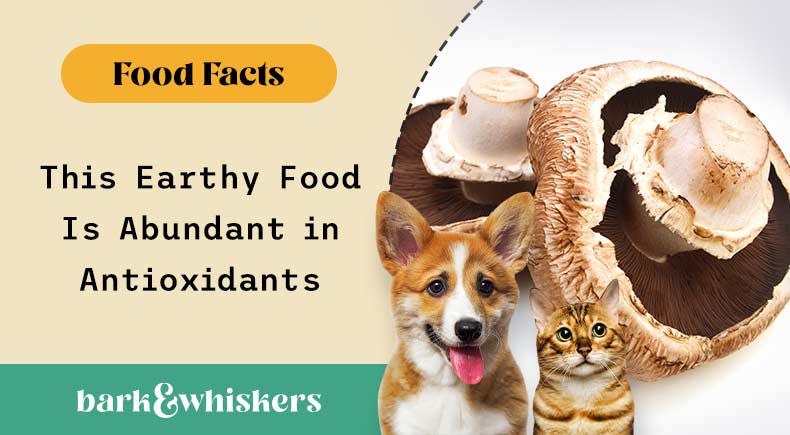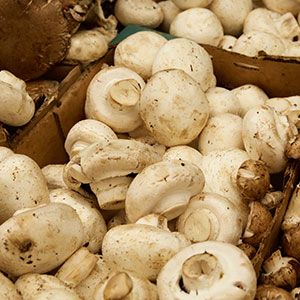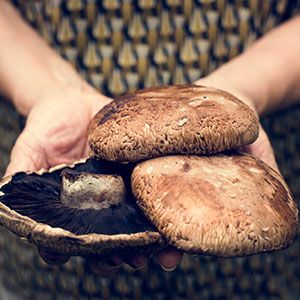Portobello Mushroom: This Earthy Food Is Abundant in Antioxidants
It's one of the best types of foods you can share with pets, as it's loaded with antioxidants that can boost immunity, slow down aging and promote mitochondrial health.

STORY AT-A-GLANCE
- Portobello mushroom’s benefits for human and pet health can be attributed to the abundance of components like polysaccharides, which may have antioxidant effects by working as adaptogens and immunomodulators
- Glutathione, which is found in all mushrooms, is called the “master antioxidant;” it has many functions in humans and companion animals, such as supporting liver function, boosting immunity, repairing tissues and protecting mitochondrial function
- Ergothioneine in mushrooms has been dubbed the “longevity vitamin” due to its potential to help inhibit chronic diseases associated with aging
- Another nutrient in portobello mushrooms, conjugated linoleic acid (CLA), has “anticarcinogenic, antiobese, antidiabetic and antihypertensive properties”
- Whatever the mushroom variety, make sure to always steer clear of mushrooms growing in the wild (unless you’re an expert at wild foraging)
- Opt for spray-free organic portobello mushrooms, whenever possible, to ensure they’re truly sustainable and free of potentially harmful chemicals
Editor's Note: This article was originally published February 15, 2023.
I’ve previously written about the many benefits of edible medicinal and culinary mushrooms for your pet’s health, as I believe this type of food is one of the best to share with your dogs and cats. Just remember this rule: Only feed your pets mushrooms that you would eat yourself. All mushrooms sold at the grocery store or market that are intended for human consumption are also safe for pets.
One of the most popular mushroom varieties in the culinary world is portobello, and it is enjoyed by humans in many ways. Continue reading to find out what benefits this versatile superfood can offer your pet.
What Are Portobello Mushrooms?
Also called portobella or portabella mushrooms, Agaricus bisporus is a large, dark-brown, meaty type of mushroom that’s known for its dense, chewy texture and rich, savory taste.1 Each mushroom measures between 4 and 6 inches in diameter, making it the largest type of cultivated mushroom.2 Its flavor is described as “umami” — rich, earthy and meaty — thanks to an amino acid, called glutamate, found in the mushroom.3
Because of widespread misinformation on the internet stating “all mushrooms are poisonous for pets,” many pet owners have ended up denying their pets the amazing healing properties of medicinal mushrooms. But don't let these myths scare you away from giving your pet these foods. Mushrooms like portobello are perfectly safe for your pets. They offer your pets protein, nutrients like B vitamins, copper, selenium and phosphorus,4 and various antioxidants that I’ll discuss in detail below.
Cremini, White Button and Portobello: Same Mushroom, Different Names

Did you know that these three mushrooms are actually one kind, just varying in maturity? The white button mushroom is the youngest variety, while the portobello is the most mature of the three. Cremini is in between — in some instances, it’s called “baby bella” or “baby portobello.”5
Portobello has a more intense flavor than the other two because as mushrooms grow and mature, they lose their water content, leaving you with a more concentrated flavor.6
CLA in Portobellos May Have Anticancer Properties
Mushrooms like portobello are dense in nutrients because, as fungi, they scavenge organic matter — they absorb the nutrients from the ground and from decaying wood, and even manure. The nutrients have various benefits to human and animal health, such as eliminating toxins from the body and scavenging disease-causing free radicals.
One of the nutrients in portobello mushrooms is conjugated linoleic acid (CLA),7 which has “anticarcinogenic, antiobese, antidiabetic and antihypertensive properties.”8 A 2008 animal study supports the notion that this fatty acid may be beneficial for cancer prevention, as it was found to help inhibit prostate tumor growth in mice subjects. According to the study authors:9
“The data provided by this study illustrate the anticancer potential of phytochemicals in mushroom extract both in vitro and in vivo and supports the recommendation of white button mushroom as a dietary component that may aid in the prevention of prostate cancer in men.”
In companion animals, CLA may also help manage weight, which may be especially helpful for obese or overweight pets. Rodent studies found that CLA helped enhance fatty acid oxidation, leading to as much as 60% lower body fat and 14% increased lean body mass.10
Bioactive Polysaccharides in Portobellos Help Boost Immunity
Portobello mushroom’s benefits for human and pet health can be attributed to the abundance of components like polysaccharides, which have antioxidant effects and work as adaptogens and immunomodulators. They also exert antitumor effects by stimulating apoptosis (cancer cell death).11 A 2022 study also noted:12
“Mushroom polysaccharides prevent oncogenesis, show direct antitumor activity against various allogeneic and syngeneic tumors, and prevent tumor metastasis. Polysaccharides from mushrooms do not attack cancer cells directly, but produce their antitumor effects by activating different immune responses in the host.”
The primary class of polysaccharides found in mushrooms are beta-glucans, which have “anticancer, immunomodulating, anticholesterolemic, antioxidant, and neuroprotective activities.”13 They work by binding to a membrane receptor and inducing these biological responses.
A 2020 study found that beta-glucans may help improve dogs’ immunity. When blood-enriched monocytes were stimulated with beta-glucans, the researchers noted increased production of pro-inflammatory and antimicrobial compounds as a response to bacterial stimuli.14 Another way that beta-glucans may play a role in immunity is via gut health. Beta-glucans may have a prebiotic effect,15 helping to feed the good bacteria in your pet’s system.
Glutathione: The Master Antioxidant in Portobello Mushrooms
Glutathione, which is found in all mushrooms, is called the “master antioxidant,” and for good reason. It has a number of functions, such as breaking down free radicals, supporting immune function and assisting apoptosis and even DNA production.16
Just as in humans, glutathione has many functions in pet health, such as supporting the liver, boosting the immune system, repairing tissues and protecting mitochondrial function.17 One 2009 study, for example, noted that ill dogs had depleted glutathione levels compared to healthy dogs, supporting the notion that having less-than-optimal levels of this antioxidant can affect illness severity and increase risk of mortality. The researchers noted:18
“In summary, GSH [erythrocyte glutathione] concentrations were significantly lower in ill compared with healthy dogs, and GSH depletion was correlated with both illness severity and increased mortality. These results suggest that GSH concentrations may be a marker of illness severity, and may be prognostic of clinical outcome in ill dogs.”
The mushroom variety that contains the highest amount of glutathione is porcini, but that doesn’t mean portobellos don’t have a lot to offer as well. In fact, these mushrooms have higher amounts of glutathione than most foods.19
Ergothioneine: The Longevity Vitamin
An antioxidant that goes hand-in-hand with glutathione,20 ergothioneine has been dubbed the “longevity vitamin” due to its potential to help inhibit chronic diseases associated with aging.21 This potent dietary antioxidant amino acid functions as an anti-inflammatory agent and may help mitigate chronic neurodegenerative illnesses. A 2020 study noted:22
“Decreased blood and/or plasma levels of ergothioneine have been observed in some diseases, suggesting that a deficiency could be relevant to the disease onset or progression.”
Ergothioneine’s beneficial effects for pets stem from its ability to help manage oxidative stress in mitochondria. It may also help protect heart and brain function.23 Ergothioneine accumulates intercellularly, inside the mitochondria and nuclei to provide protection against oxidative damage in DNA.24 In animal studies, ergothioneine had a protective effect on the liver and intestines.25,26
Top Portobello Mushroom Producers in the US

Portobello mushrooms are the most popular variety cultivated in the U.S., accounting for approximately 90% of mushroom production in the country.27
There are 33 U.S. states that grow mushrooms,28 and Pennsylvania — particularly southeastern Pennsylvania, near the town of Kennett Square29 — accounts for half of the production. California and Florida rank second and third place, respectively.30

Biologically Active Amines Promote Longevity
Another reason why mushrooms like portobello are so good for your pets is because they contain polyamines, which are valued for their longevity advantage. Polyamines, which work by binding with negatively charged molecules, like DNA, RNA and proteins, can have effects on cell growth, survival and proliferation. When there are changes to polyamine levels in your body, it can affect the aging and disease processes.31
The most potent type of polyamines in mushrooms is spermidine, which, according to one study, may have molecular and physiological effects. According to the authors:32
“Consistently, extra supply of spermidine prolongs the life span across species in an autophagy-dependent manner and counteracts age-associated pathologies such as cardiovascular disease, neurodegeneration, and cancer.”
Did You Know?

Portobello mushroom’s scientific name comes from the Greek word “agrarius,” which means “growing in the fields.” Meanwhile, its name comes from a town in Italy, where it originated.33
Are Portobello Mushrooms Sustainable?
Mushrooms like portobello are among the most environmentally friendly and sustainable crops, mainly because their farmers are able to convert waste and byproducts from other agriculture sectors, which they then use as compost. This is why mushroom growers are dubbed the “ultimate recyclers.”
Through smart management and efficient production practices, mushrooms also have a very small carbon footprint. Every pound of mushrooms requires only around 2 gallons of water and 1.0 kilowatt of electricity. Further, according to the American Mushroom Institute:34
“[I]f you added up all the emissions of carbon dioxide (CO2, a greenhouse gas) from producing that one pound of button mushrooms – from the compost recipe all the way through to what you purchase in the store – it is the equivalent of just 0.7 pounds of CO2. To give some perspective of how small a carbon footprint that is, using one gallon of fuel in the U.S. emits nearly 20 pounds of CO2.”
How to Safely Give Portobello Mushrooms to Your Pets
“Whatever the mushroom variety, make sure to always steer clear of mushrooms growing in the wild.”
Unless you are an expert wild forager of mushrooms, I recommend only feeding those that come from reputable growers and farmers markets. Opt for spray-free organic mushrooms, whenever possible, to ensure that they’re truly sustainable and free of potentially harmful chemicals.
Wash portobello mushrooms under cold running water quickly before preparing them. Research suggests the nutritional properties of mushrooms, including beta-glucans, are more accessible if mushrooms are gently cooked prior to serving.35 Steaming or sautéing them quickly in coconut oil is suggested. Since portobellos are a bit large, make sure to chop or slice them before sharing with your pet.
When using as treats or toppers, serve the mushrooms plain, without any seasonings. They can make for a wholesome training treat or a tasty meal topper to your pet’s nutritionally balanced, species-appropriate homemade diet. You can puree them and spread on lick mats, slice and stuff in an interactive toy, or use them as an ingredient in homemade training treats or homemade meals.
My easy and nourishing mushroom broth recipe provides a simple way to incorporate portobellos into your pet’s diet. You can also add other medicinal mushroom varieties like porcini and maitake.
Sources and References
- 1,3,6 The Spruce Eats, November 24, 2021
- 2 Britannica, Portobello Mushroom, Nov 19, 2022
- 4 USDA Food Data Central, Mushrooms, portabella, raw
- 5 The Kitchn, October 8, 2022
- 7,9 Nutr Cancer. 2008;60(6):744-56
- 8 Obes Res Clin Pract. 2014 Nov-Dec;8(6):e525-32
- 10 Lipids. 1997 Aug;32(8):853-8
- 11 3 Biotech. 2012 Mar;2(1):1-15. doi: 10.1007/s13205-011-0036-2. Epub 2011 Nov 25
- 12 Appl Microbiol Biotechnol. 2002 Nov;60(3):258-74
- 13 Int J Microbiol. 2015; 2015: 376387
- 14 Front Immunol. 2020 Oct 9;11:566893
- 15 Biomed Res Int. 2017; 2017: 8972678
- 16 Medical News Today, December 10, 2018
- 17 Dogs Naturally Magazine, February 2, 2022
- 18 Journal of Veterinary Internal Medicine, Volume 23, Issue 2, March/April 2009, Pages 250-257
- 19 Penn State, November 9, 2017
- 20 Food Chemistry Volume 233, 15 October 2017, Pages 429-433
- 21 J Nutr Sci. 2020; 9: e52
- 22 Febs Letters Volume 592, Issue 20, October 2018, Pages 3357-3366
- 23 Dogs Naturally Magazine, January 12, 2023
- 24 Int J Mol Sci. 2021 Mar; 22(6): 3246
- 25 J Surg Res. 2004 Nov;122(1):96-102
- 26 J Surg Res. 2008 Jan;144(1):36-42
- 27 Specialty Produce, Portabella Mushrooms
- 28 Nutr Today. 2014 Nov; 49(6): 301–307
- 29 NPR, October 11, 2012
- 30 Markon, Mushrooms, Portabella
- 31 Aging (Albany NY). 2011 Aug; 3(8): 716–732
- 32 Science, January 26, 2018
- 33 Health Benefits Times, Portobello mushroom – Agaricus bisporus
- 34 American Mushroom, Sustainability
- 35 Food Sci Nutr. 2021;00:1–8











